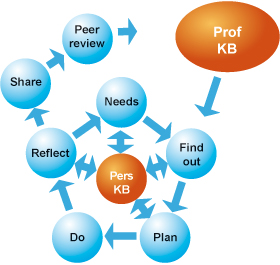Use 'Print preview' to check the number of pages and printer settings.
Print functionality varies between browsers.
Printable page generated Sunday, 23 November 2025, 6:20 AM
V33c: Researching and evaluating a digital game for the classroom
Overview of course
Computer, digital or video digital games (referred to as ‘digital games’ in this course) are increasingly being incorporated into teaching and learning as educational resources or legitimate ‘texts’. Both teachers and researchers believe there are educational advantages for including digital games in the classroom:
- they are a ‘persuasive medium’, which may influence players’ thoughts and actions
- they are popular and motivate players through gameplay alone or with others; this motivation could be used strategically to support pupils’ engagement with school-based learning tasks and objectives
- they are ideal virtual learning environments (VLEs) where pupils practise skills through authentic situated learning
- they can be played and explored as digital texts for consideration in ‘media literacy’ and can also be classed as ‘media objects’
- they support the development of skills that are important for 21st century learners such as cooperation, teamwork and problem solving, in both offline and online environments.
Similar to other texts and media, practitioners need to carefully consider why and how they want to include digital games in their individual teaching and learning contexts. The main aim of this course is to develop skills for researching and evaluating the use of digital games in your own classroom or other setting.
By the end of the course, you should be asking questions of your own, and others’, practice, such as:
- How can digital games (online, console and handheld) be used to make connections between pupils’ out-of-school use of digital media and classroom based teaching and learning?
- How can digital games be used to develop learners’ multimodal design skills, media literacy and problem-solving abilities?
- How can playing, researching or designing digital games be used as a catalyst for engaging learners in school-based activities to meet standards-driven benchmarks and outcomes?
- How could digital games be used to make teaching and learning more relevant to pupils’ engagement with digital media?
Learning outcomes
At the completion of this course, you should be able to demonstrate the following outcomes:
Professional and reflective practitioner skills
- evaluate the relevance of introducing a digital game into your teaching and learning practice
- critically reflect on other teachers’ use of digital games to inform your practice
Practical skills
- identify opportunities for the use of digital games (playing, researching or designing) in your classroom or other setting
- develop a plan and use a digital game to support teaching and learning within your classroom
Knowledge and understanding
- demonstrate an understanding of the possible advantages of including digital games in your own setting
- become familiar with current digital games research and their educational relevance
- become familiar with how other practitioners support learning with digital games in their contexts
Cognitive skills
- analyse the role of digital games for your classroom
- evaluate and research the use of digital games for teaching and learning.
The Practitioner Research Cycle
Vital Courses are based on the Practitioner Research Cycle as shown in the diagram below.

You will no doubt already be familiar with the notion of reflective practice, which typically has four stages:
- Identify needs
- Plan
- Do
- Reflect.
The Practitioner Research Cycle extends that by adding in two further stages:
- Find out
- Share.
‘Find out’ involves investigating what the wider education community knows about how to address identified needs (in order to help learn from other people’s prior experience and avoid re-inventing the wheel).
In the ‘Share’ stage you pass on what you have learnt to the wider community so that they in turn can benefit from your experiences and expertise. (This is then mediated by a process of peer review before becoming an established part of the education communities’ shared knowledge base.)
This cycle draws on, and develops, personal and professional knowledge bases (Pers KB and Prof KB in the diagram). The latter is the knowledge that underlies professional practice in education, and is reflected in the literature, resources, policies and other materials that are used to inform practice. Throughout the course icons will indicate the stage of the cycle being addressed.
This course will explicitly follow the stages of the Practitioner Research Cycle, starting with identifying needs and moving through to sharing your learning (initially within your course group). Throughout the course icons will indicate the stage of the cycle being addressed.
Course information
You will need access to:
- a computer with a web browser
- headphones (microphone and speakers) for online tutorials (a webcam is optional)
- a class/group of students – groups could be within classes, whole classes, or groups across classes (e.g. clubs) and schools (e.g. clusters of schools or in collaborative projects).
The core of these materials is a project that lasts for half a term during which time you will access online resources.
| Online hours | Collaborative (timetabled) | 4.5 hours |
| Collaborative (flexible) | 30 minutes | |
| Independent study online | 3.5 hours | |
| Sub-total | 8.5 hours | |
| Offline hours | Facilitated face to face | 0 hours |
| Workplace: Carrying out a project in the classroom | Normal classroom activities | |
| Independent study offline: learning journal | 1.5 hours | |
| Sub-total | 1.5 hours | |
| TOTAL | 10 hours |
Course schedule
| Weeks | Course Activities | Stage* | Type | Approx time needed |
| 1 | Activity 1 Getting to know others on the course | Needs | Online | 30 minutes |
| Activity 2 An introduction to digital games for learning | Find out | Online tutorial | 1 hour | |
| Activity 3 Guidance on using resources and planning for your project | Find out | Online | 30 minutes | |
| 2–3 | Activity 4 Mapping the uses of digital games for teaching and learning | Plan | Individual planning | 1 hour |
| Activity 5 Confirming plans and aims | Plan | Online tutorial | 30 minutes | |
| 4 | Activity 6 Linking digital games and learning | Plan | Individual online | 1 hour |
| Activity 7 Linking digital games and your teaching | Plan | Individual | 30 minutes | |
| 5–6 | Activity 8 Classroom project | Do | Classroom | No extra time needed |
| Activity 9 Reflective journal | Reflect | Individual | 1.5 hours (30–60 mins per week) | |
| Activity 10 Discussion with course participants and tutor | Share | Online | 1 hour (30 mins per week) | |
| 7–8 | Activity 11 Reflecting and reporting back | Reflect | Online | 1 hour |
| Activity 12 Extracting our shared learning | Share | Online | 1 hour | |
| 8 | Activity 13 Course evaluation and certification | Online | 30 minutes | |
| TOTAL | 10 hours over 8 weeks |
Footnotes
*Stage in Practitioner Research Cycle.Getting started
This course looks at how aspects of learning may be supported and enhanced through the use of digital games. Your starting point is ‘a need’ within your practice, which you will investigate how to address. This will involve exploring how other people have already attempted to address a similar need in their practice (bringing in some theory and practical examples of how particular technologies are used in schools), before you plan and implement their use in your school and reflect and discuss what worked and what needs further refinement.
At the heart of your learning is a project that you will carry out in your teaching and learning setting. You will be carrying out a project with a similar focus to others, in terms of the phase of education, technology and the curriculum.
In this first part of the course we will introduce ourselves to get a feel for the contexts we are working in. This may allow for cross-fertilization of ideas in projects and for supported reflection.
Activity 1 Getting to know others on the course 

The objective of this course activity is to get to know the other participants on this course and to identify common areas of interest.
Your task is to introduce yourself by telling the other course members what you hope to get out of the course. You will also meet the course tutor and find out a bit about her or his background.
- Go to the course forum and the ‘Introductions’ thread. There it will explain how these introductions will be done.
- Think about any game that you have played and liked (it doesn’t have to be a computer game) and explain why you liked it.
- Go to the course forum and read what others have posted. ‘Reply’ to some of these messages, identifying areas of overlap with your own context/objectives/interests/expertise.
Activity 2 An introduction to digital games for learning 

The aim of this course activity is to introduce both a ‘big picture’ view of the role of digital games and some specific examples of teachers using digital games.
This activity gives you a brief insight into the latest research into the use of digital games as well as looking at one or two examples of teachers using digital games in the classroom
Spend 30 minutes looking at one item from each column below. If you have more time, look at more of the items to give you a broader overview of this area. If you become really hooked – more resources are recommended underneath the table.
| Introduction to the research about games and learning | Examples of teachers using games for teaching and learning |
Computer Games, Schools and Young People. A Futurelab report for educators on using games for learning (47 pages). | A report of the Digital Leaders project at Stantonbury Campus, an 11–18 school, involving the use of games. |
Games and learning. A Futurelab podcast that discusses the use of computer games in the classroom, and the benefits and challenges of using games to enhance the curriculum. | A presentation from the Learning without Frontiers conference given by Dawn Hallybone on the use of games in a Oakdale Junior School supported by an article by Merlin John on the use of handheld devices and games. |
A European Schoolnet report on the study How are digital games used in schools? (145 pages – page 7 offers a useful definition of games). | A report by Merlin John on the use of consoles and games in schools. |
Further resources
- A report based on an interview with Steve Bunce from Vital on the use of games in schools
- The website for Learning and Teaching Scotland’s Consolarium – a games-based learning initiative
- A report from a teacher in an 11–16 school on the use of Kodu to design 3D games
- Kodu Training Responses and Next Steps: a report from the LTS Consolarium project on the use of Kodu.
Activity 3 Guidance on using resources and planning for your project 
The objectives of this course activity are:
- to understand the practitioner research cycle
- to review learning to date
- to begin to plan for your use of digital games in the classroom, developed further in Activity 4
- to develop an understanding of the resources available to support your learning.
Your facilitator, and others on the course, will help to you to plan and refine your ideas for this project.
Go to the course discussion forum and to the thread ‘Tutorial: Resource and project guidance’. This will contain guidance on how the tutorial will be conducted. It may use the Elluminate video conferencing system for which will you need headphones or a microphone and speakers. A webcam is advantageous. The tutorial will be supported by discussion in the forum. When you attend the tutorial, online, you should be prepared to discuss initial ideas for your project.
Planning the use of digital games in your classroom

In weeks 2 and 3 you will start to plan how you will include and use digital games in your classroom.
Activity 4 Mapping the uses of digital games for teaching and learning 
The objective of this course activity is to map the use of digital games in your classroom.
This activity recognizes that classrooms are complex places and that introducing a new technology such as digital games can be difficult. During this activity you will begin to create a map (or planning sheet) of how digital games can be used in your classroom. This task is designed to support you in thinking about how using a game fits with your personal, classroom and school-wide objectives. [ For those interested in understanding this approach further, it builds on a ‘Layers of Influence’ model which can be found on page 16 of Futurelab’s Barriers to Innovation report.]
You need to complete the linked mapping sheet.
When you have completed this task, save your sheet and share a link with others in your group. This information will enable your tutor to match appropriate digital games to your learning aims.
Activity 5 Confirming plans and aims 
The objectives of this course activity are:
- to discuss your aims with the course tutor
- to be introduced to a number of digital games and practices relevant to your plan.
Once you have completed the mapping sheet you should discuss it with your facilitator and others. This will be done in a tutorial using Elluminate. The tutorial will be supported by discussion in the forum. When you attend the tutorial, online, you should be prepared to discuss your project plans.
Go to the course forum and to the thread ‘Tutorial: Confirming plans’. Upload your plan and comment on others’ plans that are there. The thread will also contain guidance on how the tutorial to discuss plans will be conducted. By sharing your map and aims with the facilitator and others, you have the opportunity to look at digital games resources related to your plans and be given some focused feedback based on aims that you have identified.
Supporting teaching and learning with digital games
In weeks 3 and 4 you will look out how the digital games you have identified, and others, can support teaching and learning in your classroom.
Activity 6 Linking digital games and learning 

The objectives of this course activity are to:
- review other teachers’ uses of digital games for learning
- become familiar with one other online game.
Once you have completed your tutorial, you should review the resources in Activity 1 to identify those which are now most relevant to your practice.
Use the form, Reviewing and planning for digital games in your teaching, to review the practices and examples given – you only need to fill it out once when analysing the practice you’d most like to develop – but use the questions on the form to help you mentally analyse the practices.
At this stage just fill out the first column ‘Review’.
Once you have completed the first column of your form, share it online in the forum. It will be useful to review other teachers’ forms and to support them by commenting on them.
Activity 7 Linking digital games and your teaching 
The objectives of this course activity are to:
- evaluate digital games against your own learning aims/outcomes
- develop a plan for your own use of a game in your classroom.
The review form used in Activity 6 provided you with a chance to detail the benefits of one approach to using digital games in the classroom.
Using the second column of the form (marked ‘Plan’) now begin to fill out the form in relation to the activity you hope to develop. This document will form the basis of your classroom project. Once completed, share online and comment on at least one other plan.
Implementing your digital games project

Now you implement your project, and reflect on and discuss what you have learned in the process.
Activity 8 Classroom project
The objective of this course activity is to carry out your plan for using digital games in your classroom.
Having developed your plan on how to use digital games in your classroom you now need to carry out the project. This will last for about half a term. Each week, as you work through the project, you should reflect on what you have learnt and the impact on your pupils . You should be prepared to share your thoughts and reflections with others on a weekly basis or more if desired.
It is not intended that, in doing so, you spend any extra time over and above your normal teaching and preparation time.
Activity 9 Reflective journal 
The objective of this course activity is to reflect systematically on what you have learnt.
Each week you should note down what you have learnt from the project. This might take the form of reflection on your plans across the activities. These reflections may be kept in a blog or some other electronic journal. You will need to use these reflections to inform your responses to the final activities.
Activity 10 Discussion with course participants and tutor 
The objectives of this course activity are:
- to share and reflect on your learning as the project progresses
- to gain support from colleagues on the course
- to provide support for others on the course.
Go to the course forum and to the thread ‘Project discussions’. Share how your project is going, what you are learning and any other resources that you have found to be of use. You can also use the forum to ask for support and guidance and to support and guide others. You should check back into the forum regularly – little and often is probably the best method here (15 minutes every other day is likely to be much more useful than a one hour block once a week).
Reflection, and evaluation and certification
In these final weeks you will discuss the comments made around the lesson plans and the course in general, as well as provide feedback and if required, receive certification for completing the course.
Activity 11 Reflecting and reporting back 

The objectives of this course activity are:
- to share your reflections on the outcomes of your project
- give feedback to others as they reflect on the outcomes of their project.
Your task is to discuss and share your reflections with others. Go to the forum, and the thread called ‘Reflections’ to discuss the following:
- the extent to which your intended learning aims were achieved
- the evidence you have for this
- the ways in which you shared your project with others in your setting
- key reflections on how you think you could use other digital games in your classroom.
The use of technology in learning and teaching will provide you with evidence that may be useful when considering the Professional Standards for Teaching. You will have collected evidence from planning through to your notes and evaluation to discussion in the forum. Such evidence may be useful to you when demonstrating ways in which you have met the standards.
Depending on the stage of your career, certain TDA standards may be more relevant than others. Click the ‘Discussion’ button to reveal a possible set of standards. If appropriate, you can reflect on these standards as part of your feedback for this activity.
Discussion
- C7: Evaluate their performance and be committed to improving their practice through appropriate professional development.
- C8: Have a creative and constructively critical approach towards innovation; being prepared to adapt their practice where benefits and improvements are identified.
- C27: Design opportunities for learners to develop their literacy, numeracy, ICT and thinking and learning skills appropriate within their phase and context.
- P10: Contribute to the professional development of colleagues through coaching and mentoring, demonstrating effective practice, and providing advice and feedback.
- E2: Research and evaluate innovative curricular practices and draw on research outcomes and other sources of external evidence to inform their own practice and that of colleagues.
- E14: Contribute to the professional development of colleagues using a broad range of techniques and skills appropriate to their needs so that they demonstrate enhanced and effective practice.
Activity 12 Extracting our shared learning 

The objectives of this course activity are to discuss and to develop a common understanding of what we have learnt as a group.
Go to the course forum and, in the Discussion called ‘Shared Learning’, post the key learning points that have emerged for you during the course.
Activity 13 Course evaluation and certification 
The objective of this course activity is to complete an evaluation form and, if you wish, print a course completion certificate and rate and review the course.
Your task is to complete the evaluation questionnaire, which can be found on the course page. There are also links there to print a certificate and rate the course. The certificate will be ‘released’ by your facilitator.
References
Acknowledgements
This course has been developed in collaboration with Futurelab. For more information about Futurelab and to access a range of related resources, please visit www.futurelab.org.uk
Author: Dan Sutch
Reviewers: Joy Hooper, Pete Bradshaw and Christopher S. Walsh
Editor: Matthew Driver